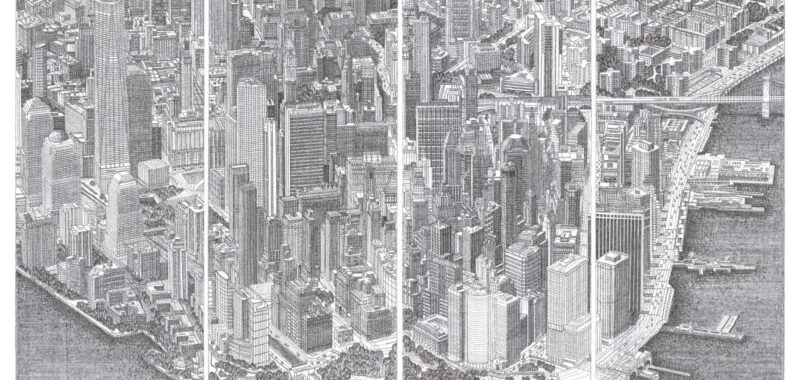Behold—Gotham. In this “typiction,” British architecture student turned artist James Cook recreated the skyline of Lower Manhattan using an old and slightly broken 1963 Olympia SG3 typewriter. The image, which measures about 3 feet by 4 feet, was realized in four vertical panels containing over a million hand-typed letters. It took Cook 400 hours to make the piece; he typed about six hours per day, five days a week for over three months. He told AN that the piece “captures the iconic skyline but also intricately weaves in hidden typed gems like street names, coffee shops, and local businesses which tourists and locals will be familiar with if they have ever visited the Big Apple.” He made it at the end of 2023, just in time for New York’s 400th birthday.
Since starting to make art with typewriters in 2014, Cook has created more than 350 typewritten drawings with 100 different typewriters, most of which have been donated to him by fans. His works often take buildings or urban scenes as subjects. In these, “each component of a building such as a windows, brickwork, doors, and roof tiles are all represented in a language that is made from letters, numbers, and punctuation marks,” he said.
Cook studied architecture at the Bartlett School of Architecture in London from 2015 to 2022, earning undergraduate and postgraduate degrees before working briefly for Metropolitan Workshop. During the COVID-19 lockdown, after finishing his second degree, he decided to take on typewriter art as a full-time job, instead of a hobby: “I felt like I had nothing to lose and from very slowly and organically building a strong following from Instagram over a decade of work, I felt like I could expand on my art practice and fulfill those ambitions and projects that I had always dreamed of doing.”
Obsessed with architecture from a young age, Cook now crafts portraits of the built environment from many scenic vantage points, including balconies overlooking London, the stage of Royal Albert Hall, and the top of Battersea Power Station. Many of his artworks use an isometric projection—a drawing style familiar to any architect. There’s also a dimensional aspect to the actual surface of his pieces: “The texture of the work is defined by the scratchiness of sharp, solid shapes of the alphabet, numbering, and punctuation of the typewriter’s typeface. It is how this jumble of information is organized onto the page that allows me to create a piece of artwork. One beauty of typewriter art is that the metal hammers of the machine leave an embossed mark on the page, giving the work almost 2.5 dimensions.”
Cook has found success via Instagram, where he has over 600,000 followers on his @jamescookartwork account. He often posts videos of works in progress. “It’s the sensation of being ‘a fly on the wall’ when watching the video, moving from camera angle to camera angle, changing positions, hearing the mechanical sounds of the typewriter, the ding of the bell, and the winding noises of the carriage return that offer an ASMR-style of viewership. It leaves people wanting to see more,” he said.
In addition to this panorama, Cook has typed portraits of New York skyscrapers like the Woolworth Building and the Empire State Building. (All are available for sale on his website.) He shared: “What I love about creating my typewriter art is watching people who see the work spend a considerable amount of time looking really close-up at the drawings, trying to identify all of the hidden typed messages that I conceal in my artwork.”
What’s next? Cook is currently working on a book project in which he is typing portraits of 50 famous authors. He is also angling for more architectural commissions. “I am hoping that architects who read this feel encouraged to reach out to me if they have an exciting project they would like me to come and type!”

